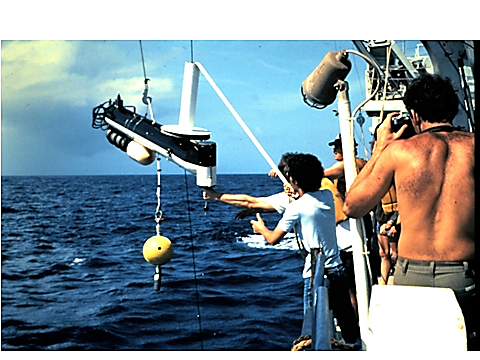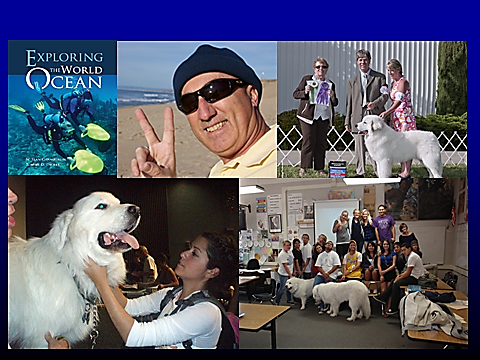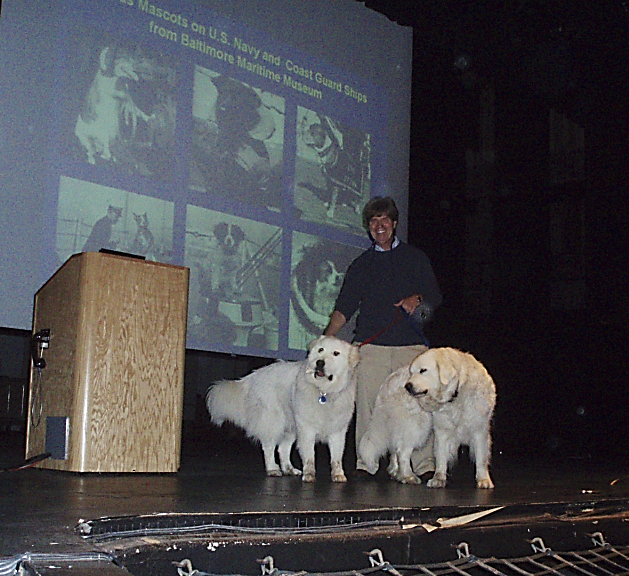Professor Tommy Dickey presented a talk entitled “The Challenges and Rewards of a Career in Field Oceanography” at the May 30, 2013 UCSB Geography Colloquium and Student Award Presentations. Following are extracts from his fascinating and inspiring presentation; a complete summary, with photos, can be found here.
I often hear students expressing concern about choosing a successful career path, and some are even anxious to learn how I came to be an oceanographer. In this talk, I have used my life and professional career experiences, some serious and some amusing, to tell about some of the lessons I have learned. I grew up in a very small farm town in Indiana named Farmland – a name that my Princeton thesis advisor did not believe until he found it in an atlas! As the son of a small town sportswriter, sports have been an important part of my life. In fact, my father let me write a short article for his column when I was only about 10 years old, making me a bit of a local (very local!) child celebrity! […] After high school, I received scholarships to attend Ohio University (OU) where I completed degrees in Physics and Math. […]
During the Vietnam War, my career path took a detour as I served for about four years as an electronics technician instructor and a human relations instructor in the U.S. Coast Guard. Still intent on obtaining a Ph.D. in the physical sciences, I lived on Staten Island, New York and enrolled in night classes at Stevens Institute of Technology in Hoboken, New Jersey (both communities were devastated in October 2012 by Hurricane Sandy). My studying was done mostly on the Staten Island ferries and the U.S. Coast Guard ferry during shuttles between Governor’s Island, Manhattan Island, and Staten Island; the ferries passed the Statue of Liberty daily (a place I have never actually visited!). Interestingly, I had one cruise on a Coast Guard cutter and over 1000 “cruises” on each of the ferries! Somehow, I was able to juggle my service duties and attend enough classes to complete an M.S. degree in Physics at Stevens Tech and even taught a few extension courses for the New York Institute of Technology before receiving my honorable discharge. Lesson #1: Stay positive during adversity. Lesson #2: Be persistent. Set goals and have a plan. My persistence was about to pay off!
With the completion of four years of military service, I was anxious to go to graduate school full time. But in what discipline? Four years earlier, I had been accepted to study Physics at UCSB of all places! While teaching at the U.S. Coast Guard Training Center, I met Coast Guard marine science technicians and found the books they were using to be fascinating. The classic book, “The Oceans: Their Physics, Chemistry, and General Biology” by Sverdrup, Johnson, and Fleming, was loaned to me. I was hooked by this book and an introductory meteorology book as well as a classic ecology book by Eugene Odum. My interdisciplinary career path began at this juncture. So when I learned that Princeton University had recently initiated a new program in geophysical fluid dynamics (part of the newly formed Geophysical Fluid Dynamics Laboratory (GFDL) under a joint agreement between Princeton University and the National Ocean and Atmospheric Administration (NOAA), I applied and was accepted. Lesson #3: Determine what kind of science and issues you are passionate about. In my case, it was geophysical fluids. […]
I did my Ph.D. thesis on laboratory generated internal gravity waves and turbulence under Professor Mellor, who was developing some of the most advanced atmospheric and oceanic turbulent boundary layer models. Later, he developed the Princeton Ocean Model (POM) with Professor Dr. Alan Blumberg, who is now a professor at Stevens Tech. POM is likely the most widely used ocean circulation model in the world. Princeton’s GFDL was a crucible for atmospheric and oceanographic models. Many of today’s atmospheric and oceanic general circulation numerical models can be traced back to GFDL professors and researchers. […] I was indeed fortunate to have experienced a paradigm shifting scientific endeavor at its early stage. Lesson #4: Learn from and respect others.
Though I had done theoretical work at Princeton, my real interest was in experimental research. Thus, upon graduation with my Ph.D., I accepted a Rosenstiel Fellowship at the University of Miami to gain experience as a sea-going oceanographer under the guidance of Professor Claes Rooth. Cruises on the RV James Gilliss and NOAA’s RV Researcher convinced me that ocean field work would provide me with the most scientific enjoyment. After the Miami experience, I was recruited by Dr. Don Walsh to be a professor at the University of Southern California (USC). In 1960, Dr. Walsh, then a Navy Lieutenant, and Jacques Piccard made the historic first dive to the deepest depth in the ocean, the Marianas Trench. At USC, I continued to enjoy teaching and learned how to get research proposals funded – keys to academic success! […]
The Office of Naval Research and the National Science Foundation began to embrace large interdisciplinary field experiments, and, thus, my time at Miami where interdisciplinary research was beginning to be nurtured served me well. I began developing instrument packages with the engineering expertise of Derek Manov that simultaneously measured physical, optical, and chemical variables. Some were very successful and others were sadly lost at sea! This included the Multi-Variable Profiler, which was apparently attacked and destroyed by a nearby mother killer whale protecting her baby. I learned a hard lesson. Don’t paint profilers black and white!
Deep sea moorings became our next platform of choice to collect depth dependent high temporal resolution interdisciplinary data sets. Study sites included the North Atlantic near Bermuda and Iceland and off the east coast of the U.S., the Arabian Sea, the Mediterranean Sea, the equatorial Pacific, and the central and northern Pacific and off the west coast of the U.S. and off Hawaii (see www.opl.ucsb.edu). To date, our group has done about 150 research cruises. Problems of interest have included bio-optical variability and imaging, mesoscale ocean eddies and their roles in carbon sequestration and ocean ecology, biological and physical upper ocean responses to hurricanes, interdisciplinary equatorial processes involving tropical instability waves and El Nino-Southern Oscillation (ENSO), and the physical and biogeochemical oceanic variability associated with monsoons. Most of these studies remain of interest in regard to climate change, ecosystems, and biogeochemistry and are used by data miners to this day. Lesson #5: Expect your goals and plans to change and adjust. My interests evolved from the theoretical to the laboratory to the field. All three are important and I especially appreciate the theoretical and laboratory education I received at Princeton and the sea experiences at the University of Miami.
My career has enabled me to meet many interesting and influential oceanographers including the aforementioned Princeton professors and Professor Ted Fujita. As an ONR Secretary of the Navy/Chief of Naval Operations Chair, I continue to interact with amazing oceanographers such as 95-year young Walter Munk who contributed to the wave forecasts for the D-Day invasion of Normandy during World War II and Dr. Robert Ballard of Titanic (and many other shipwrecks) discovery fame. I have been blessed with the opportunity of working with great colleagues, students, and post-doctoral fellows. From our own department, I worked for several years with former Geography Department chairman and Jerlov Award winner Professor Ray Smith and both Professor Dave Siegel and Professor Libe Washburn who were with me at USC. Again, Lesson # 4: learn from and respect others. […]
Many of my former students have seen me on campus and excitedly recounted stories about these polar explorers along with the names of my Great Pyrenees dogs well after completing my classes! Yes, my Great Pyrenees Pyrfessors are somewhat legendary. […] One day, I was lecturing about the southern California Bight, and my Great Pyr Theodore Nansen ambled up to the chalk board and stood on his hind legs and pointed right at the Bight! My Great Pyrenees indeed serve to attract and amuse students. As certified and award winning therapy (and show) dogs, they visit UCSB during Therapy Dog Day each quarter, participate in Special Olympics events, and visit high schools and the elderly. Lesson # 6: grow through community service doing activities that you enjoy. In my case, I enjoy my amazing Great Pyrenees dogs who do all the therapy ‘work’ by just being themselves.









